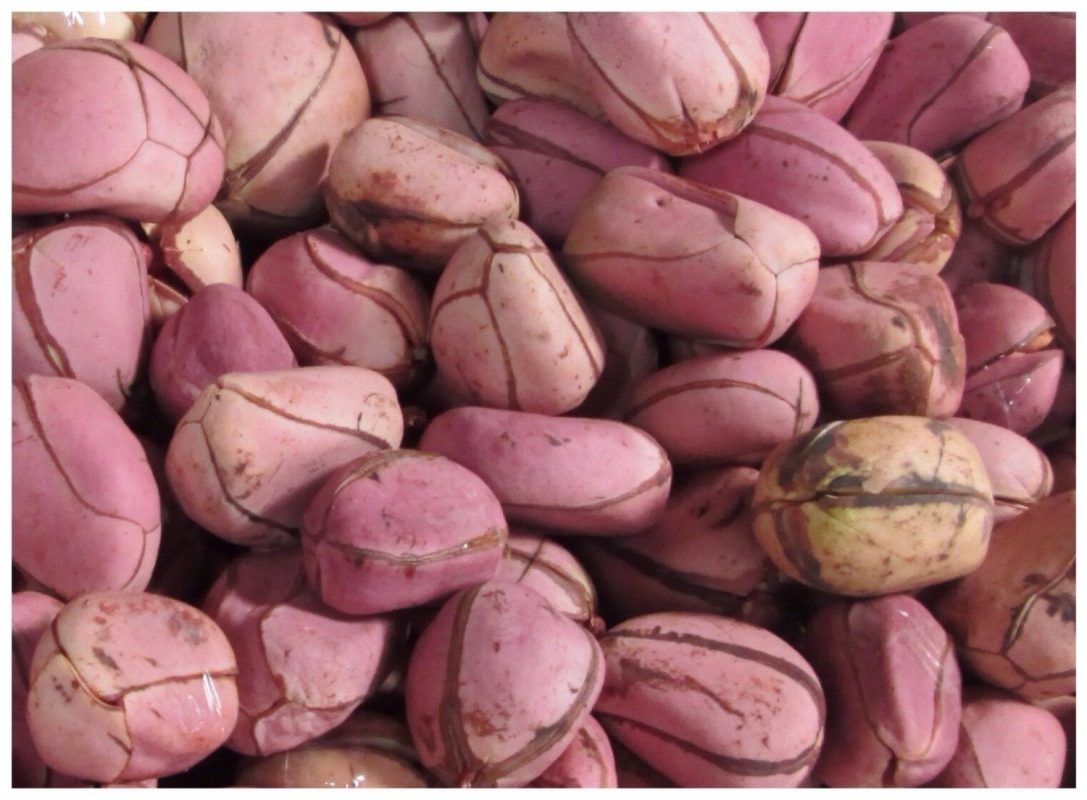Products
Kola Nut (Obi Abata): Uses and Benefits
Kola Nut (Obi Abata)
Contents
Kola nut is the seed kernel for a significant African tree that is cultivated extensively around the globe, especially in Nigeria, Sri Lanka, Indonesia, Brazil, and some parts of South America. As a caffeine-containing stimulant, it is highly prevalent among people. The nuts are eaten either whole or powdered and are mixed with certain liquids to make a drink.
The kola nut comes primarily from three kola nut (Obi Abata) species: Cola acuminata, Cola nitida, and Cola vera. The kola nut tree has its origins in West Africa, but as a result of the slave trade, you can find it in Brazil and the West Indies. The kola nut tree typically grows to a height of 25 meters or 60 feet; its waxy oval leaves frame colorful, star-shaped flowers that are either white or yellow blooms with violet highlights. Its fruit is pod-shaped, with about a dozen reddish fruits or cola nuts sitting in each.
The Kola nuts may be red, purple or pink. (Once opened, the structure of the seedpod exposed feels quite comparable to the armor of an armadillo!). The aroma of the nut is nice and rosy, and it has a sour but pleasant flavor when it is chewed. Kola extracts can be removed by cooking the nuts.
For many ethnic communities in Nigeria, the Kola nut is an important cultural symbol. It is offered to guests at weddings and funeral ceremonies. Ceremonial breaking of the kola nut is vital for welcoming people to a village or meeting. It is also used in the field of medicine.
Kola nut serves two main purposes; they include medicine and food.
Medicinal uses of Kola Nut (Obi Abata)
Kola nut is high in caffeine and has many other phytochemical compounds, such as betaine (the chemical component that gives it the red color), phenolics, tannins, Theobroma, and theophylline. It’s bitter; its astringent flavor is used as a digestive aid to stimulate gastric juice and bile production before eating. The high caffeine content and Theobroma make it a powerful neurostimulator used to combat fatigue.
The nut and its extracts have also been successfully used as vasodilators for treating respiratory conditions such as asthma and whooping cough because its high concentration of caffeine, theobromine and theophylline dilates blood vessels to allow more efficient and unhindered circulation. Additional uses include toothache therapy, treatment of diarrhea, exhaustion, headaches, starvation and malaria, as anti-malaria, a poison antidote, sedative, stimulant, and tonic (which is an efficient appetite suppressant).
Kola Nut (Obi Abata) As food and flavoring for drinks
West Africans, laborers and farm workers often use kola as a pep-me-up between meals, although the practice among young people is said to be diminishing. Nevertheless, before meals, the kola nut is still used as a type of aperitif to enhance the taste of the food, as it stimulates the production of saliva and cleans the palate.
It is a source of certain B vitamins (thiamine, riboflavin, niacin), proteins, starch, and sugar. Muslims in Africa often replace alcohol with kola nuts because their religion prohibits the use of alcohol. Although they contain 1-3.5% caffeine, it is not addictive. It is also responsible for the distinctive flavor of colas, soft beverages, and tonics. In May 1886, the US pharmacist Dr. John Stith Pemberton collected kola nut and coca extracts and mixed them with sugar, carbonated water, and coca to form the first Coca-Cola recipe.
From that time till today, it has been used in many other soft drinks as a flavoring. Although Coca-Cola no longer uses Kola nut, it uses synthetic products that simulate its flavors.
Chewing the Kola nut (Obi Abata) regularly every day can stain your teeth and give them a very rusty color. Medical science shows that kola nut has a high nicotine level, which can adversely affect the chemistry of the body. This can lead to sleeplessness, hypertension, elevated heartbeat, high toxicity, stimulation, and locomotive effects.
Despite some of these adverse medical reports, kola nut is a high-priced commodity with vast economic prospects.

